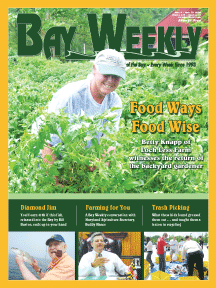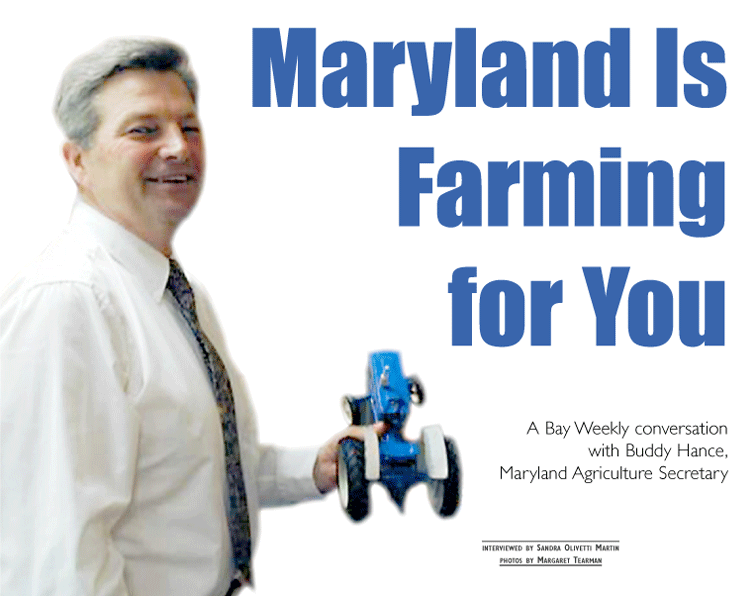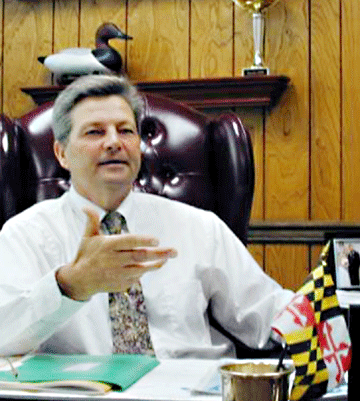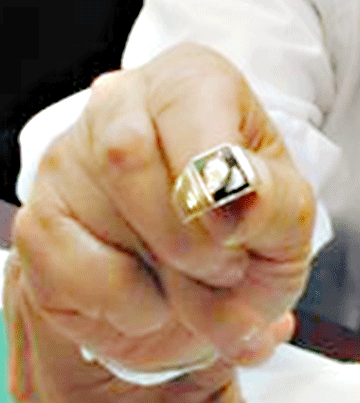
Volume XVII, Issue 23 # June 4 - June 1, 2009 |
 |


Who’s growing what I eat?
That’s a million-dollar question nowadays, because so many of us are asking it.
Our 20th-century binge on processed food has given us bellyaches — not to mention obesity, diabetes, E. coli, brain-wasting disease and pesticide poisonings.
All those years we were gobbling up the contents of every box, bottle and tube arrayed on grocery store shelves, farmers turned their labor to field-crops to feed the processing machine. The vast bulk of what’s grown in American fields is transformed into animal feed and, in the last few years, ethanol. And in Maryland, until this century, into cigarettes, for tobacco has always been part of our story.
Now, consumers and farmers are holding a reunion. Our appetites for fresh, local food — food with a history we can trace back to its farmer and field — have grown so hearty that farmers can sell a bushel of sweet corn for a better price than a bushel of feed corn.
How we got from there to here is this week’s story, told from the inside perspective of our Chesapeake neighbor, Maryland’s newest Agriculture Secretary, Earl F. Hance.
Nattily suited, with a duck on the wing holding his flowered tie in place, the fourth-generation Calvert County farmer who everybody calls Buddy says he’d rather be on his tractor than at his big desk.
¶ ¶ ¶
BAY WEEKLY Preserving family farms is part of your new job as secretary of Maryland’s Department of Agriculture. That’s a natural for you.
BUDDY HANCE I have an off-farm job, but I’ve spent nights and weekends on tractors. That’s what I really love.
I’m not here as a job. Something clicked in me many years ago to stand up for agriculture. I got involved and active in organizations. That’s why I’m here. I took this on to help agriculture, not because I couldn’t make a living on the farm any longer.
BAY WEEKLY How long has your family farmed in Calvert County?
BUDDY HANCE The farm I live on, on Hance Road off Broomes Island Road, was purchased by my great-grandfather in 1905. The other farm we have on Broomes Island Road was purchased by my parents in 1946, and I purchased a piece of property on Mackall Road in 1997. The family together, we own about 200 acres and farm 400 acres [including rented land].
From Tobacco to Food and Flowers
BAY WEEKLY You were a tobacco farmer, which leads us to one way Maryland farmers are redefining what’s profitable. Were you the last of a line of tobacco growers?
BUDDY HANCE Yes, back to my great-grandfather.
In those days, most of the Calvert community were watermen, farmers or both. So my father, grandfather and great-grandfather farmed and did something on the water, oystered in winter, fished in summer, had a sawmill.
Looking back, it was a wonderful lifestyle — maybe not so much when they were living it. My father and grandfather made a good living off a small farm compared to today, and they had time to do other things. My father hunted and fished, and now it seems all we have time to do is work. Today’s profit margin is such that you have to expand operations.
|
|
Maryland Secretary of Agriculture Buddy Hance wears a ring bearing a miniature, gold tobacco leaf to remind him of his roots. |
![]()
BAY WEEKLY You helped set up the tobacco buy-out for Maryland farmers.
BUDDY HANCE A handful of us constructed the buy-out. Tobacco was very good to Southern Maryland for 375 years, but profit margins were narrowing, and it came to the point you couldn’t find local labor. So we thought long-term and stretched the buy-out payment over 10 years, which gave producers a stream of income while they transitioned into something else.
It was contentious. Some farmers were angry we’d consider such a program. The program was voluntary. In the end, farmers would decide, and in the first year, about 71 percent did, which said to us we had developed a good, sound structure for transition.
BAY WEEKLY That tobacco buy-out money has helped keep Maryland’s family farm tradition alive. How has that worked for you?
BUDDY HANCE We went from growing tobacco to growing flowers. We had a unique situation. We had begun growing tobacco transplants in greenhouses for our own use and selling to other farms. So we had greenhouses in place at the same time Bell Nurseries in Burtonsville signed a contract with Home Depot to supply bedding plants.
They taught us how to grow, and we had a market. We were lucky, and it’s better to be lucky than smart.
BAY WEEKLY Can income from bedding flowers equal tobacco?
BUDDY HANCE Flower income is different. It’s a short season, five months, and on that basis the income is comparable. But not enough to take off the other seven. It gives you time to do other things.
BAY WEEKLY What replacement crops and agricultural activities — with what income potential — have farmers evolved to since the buy-out — a decade ago?
BUDDY HANCE We’ve had an amazing growth of vineyards and wineries, though we have much greater demand from wineries than we have grapes. Calvert has five wineries, more than any other place in the state. None of those were tobacco farms. We’d just gotten out of one labor-intensive crop and did not want to jump into another.
There are also a lot of vegetable farmers now, and greenhouses all over.
Farming for Us
BAY WEEKLY What kind of change in supply and demand of local and even organic Maryland-grown foods have you seen?
BUDDY HANCE Tremendous. All these new neighbors also create lots of opportunity. They’re a ready market at our back door, and we’ve got to figure out how to meet it, whether it’s flowers, fruits, vegetables or crafts, because consumers tell us, in the survey we do every year, they want locally grown products. They have comfort in that they believe they’re safe to eat.
It turns that revenue back to the countryside, protects open space, keeps farmers on the farm and reduces our carbon footprint — we’re not trucking those tomatoes all the way from California and burning all that fuel. So there’s no downside to buying locally.
BAY WEEKLY It must take a whole system to make locally grown foods natural choices as we shop, cook our meals and set our tables. Do you, for example, work with grocery stores to encourage them to buy locally from farmers so we can buy locally from them?
BUDDY HANCE Yes. This past March we had a buyer-grower meeting, where we sent out an invitation to producers to set up displays to show what they have to sell, and to grocery stores or any purchaser. We had over 200 people, which highlights how this movement is taking off. Whole Foods, Giant, Graul’s, Wal-Mart: They’re all trying to get into the buy-local market.
It’s there. It’s not something we’re dreaming about or something that might happen the in future. It’s here right now.
BAY WEEKLY How do farm markets — from market stands to farmers’ markets — fit in?
BUDDY HANCE Maryland now has 93 farmers’ markets that we recognize. Farm stands and farmers’ markets are the best way that a farmer goes direct retail. A farmer having a stand out on the side of the road is his best opportunity to get his greatest value out of his crop. Especially small tracts. A lot of our farms in Southern Maryland are small; they average 60 acres or less. So you’ve got to get all the value you can out of what you produce.
BAY WEEKLY How about Community Supported Agriculture farms?
BUDDY HANCE The benefit is not only good, fresh produce but also the real connection to the farmer. You’re investing in that operation in February, and if we have bad weather, you feel his pain, because instead of getting two bags of groceries, you may only get one.
BAY WEEKLY What forces do you credit with changing the way we eat?
BUDDY HANCE What I think has happened is the media has highlighted these events over the last several years of E. coli in lettuce and peppers and BSE [mad-cow disease] in cattle. People are much more aware now of food safety. We haven’t had any issues in Maryland, thank goodness [knocking on wood]. People believe the food we produce here is safe.
We import a lot of things that we really don’t know how it was grown, under what conditions. We have vigorous pesticide regulations, but every day we truck stuff across the border from Mexico, and we don’t have a clue.
BAY WEEKLY Do you eat anything off your own land?
BUDDY HANCE Yes. I have a garden. The governor has a garden at the Statehouse. Everybody should have a garden. The University of Maryland’s Grow It, Eat It campaign has 600-plus people so far in the network. They’ve taught 124 classes to 2,500-plus people in 16 counties plus Baltimore City. And they’ve had 360,000 hits on their website: www.growit.umd.edu.
 |
“Buying locally turns revenue back to the countryside, protects open space, keeps farmers on the farm and reduces our carbon footprint. There’s no downside to it.” |
Farming the Bay
BAY WEEKLY Much of Maryland’s bounty comes from Chesapeake Bay. As we transition from the wild harvest of oysters to aquaculture, can farmers’ transition from tobacco be a model to help watermen?
BUDDY HANCE When Gov. O’Malley learned that Virginia is way ahead in oyster aquaculture, he asked that we come back in 30 days with a plan to increase. Department of Natural Resources controls water leases, and we work to help aquaculturists market. This year, legislation passed to open up leases.
In my opinion, even though I think we must do everything we can on land to help, we’ll never clean up the Bay until we fill it up with oysters again.
A couple of aquaculturists are very successful, and where they are, there’s also success in cleaning up water quality. So our mission is to expand aquaculture throughout the Bay and get filter feeders back into the water.
Farming for the Bay
BAY WEEKLY In terms of Chesapeake Bay restoration, you’ve said before that farmers have worked hard to reduce runoff.
BUDDY HANCE I live on Battle Creek, and every day I look at my farm and the water and clearly understand the relationship and would not do anything on my farm to harm the water. Farmers look at the land and water as legacies.
Farmers have always done a good job. As the technology improves, they’ve adopted every improvement: Grass buffers along waterways, no-till [planting], nutrient management. Cost sharing helps farmers [afford to] implement best-management practices. The [state pays a part, and] they have to contribute a percentage based on their finances. But every year, more farmers want [to sign up] than we have funds.
BAY WEEKLY As the new secretary of agriculture, what are you asking farmers to do for the Bay?
BUDDY HANCE Right now, we’re focused on attaining two-year plan goals. We’re working to get more cover crops and streamside buffers.
Last year, we had a 25,000- or 30,0000-acre increase in cover crops [planted over winter to protect bare soil]. We’re looking for ways to increase.
